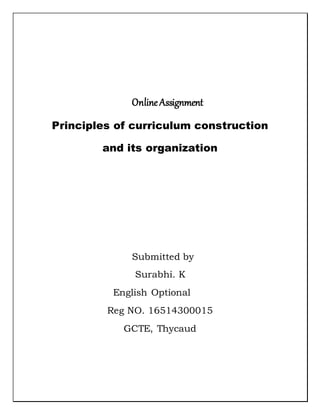
ONLINE ASSIGNMENT
- 1. OnlineAssignment Principles of curriculum construction and its organization Submitted by Surabhi. K English Optional Reg NO. 16514300015 GCTE, Thycaud
- 2. INTRODUCTION Curriculum is the crux of the whole educational process. Without curriculum, we cannot conceive of any educational endeavor. School curriculum of a country, like its constitution, reflects the ethos of that country. The term curriculum derives from the Latin word ‘currere’ which means a kind of route which the learner travels. All the activities going on the school or outside of the school is called curriculum. It is basic to the intellectual, physical, moral and emotional development of the child. Usually the term curriculum is understood to mean a group of subjects prescribed for study in a particular course. But curriculum is not confined to this narrow concept. The curriculum should in no way be considered as synonymous with courses of study .The courses of study list much of the content to be learnt and indicate some of the major activities but these from only part of the curriculum. Curriculum should be considered as a broad –based term encompassing every aspect concerning the study of the course .It is now
- 3. considered as the totality of experiences to which a pupil is exposed within the boundaries of the cool and outside. Principles of curriculum construction Curriculum organization is a scientific process which involves basic principles on which its credibility exists. It is not just collection of topics, because it reflects ethos (philosophy/culture) of the society: themes of the subject and learning variability. 1. Principles of Child-Centeredness Curriculum is mainly for the students. So, the age, interest, capability, capacity, aspiration, needs and psychology of the learner should be taken in to an account. 2. Principles of Community-Centeredness The social needs and the local needs of the learner should be taken into account while we construct the curriculum .It should be reflect the values of democracy, ethos and main concerns of the country.
- 4. 3. Principles of Balance/ Integration. (Child=Community) It is also called principles of integration. The curriculum should integrate; 1. Cognitive, affective and psychomotor objectives and abilities.2.Knowledge and experience 3.Objectives and content.4.Child’s activity and needs with the society needs activity .It should be related to the social environment of the students. Here the equal/balance importance should be given to the Child and need of the Community. 4. Principles of Needs Curriculum helps in fulfilling the various needs of the learner .Each learner has his needs which are generally related to physical, emotional and social development. A well planned curriculum provides all such opportunities through many fold activities which satisfies the needs of the learner. It should not be merely the academic but it should include all other equally important activities too. 5. Principles of Utility
- 5. One of the purposes of education is to prepare the child for living and learning .This is the most important consideration, so that the child can live a fruitful and self-fulfilling life .Curriculum should provide rich experiences, both academic and social to the students. The content, activities and experience of the curriculum at a particular stage/ grade are useful to the learner for the further/higher studies. 6. Principles of Creativity It should place the pupil in the place of the discoverer and provision should be made the creative types of activities. 7 .Principles of preservation/Conservation It should help in the preservation /conversation and transmitting the knowledge, traditions, standards of conduct on which the culture and civilization depend. 8. Principle of Variety In a classroom there are different types of the students on the basis of intelligence, ability, aptitude and attitude. The curriculum should satisfy the variety of knowledge, varying interest, needs of the students.
- 6. 9. Principle of Elasticity/Flexibility Flexibility is an important parting curriculum development .It should given enough time and sufficient chance to the students, to search their own examples and experience from the surroundings. 10. Principle of ContemporaryKnowledge Curriculum should give the modern or current knowledge and theories to the students. That will give the knowledge of utilization of local resources (salt, plants, soil) to the students. While organizing the curriculum the following principles also should be followed: 11. Principles of sequencing 12. Principles of Continuity 13. Principles of Accuracy 14. Principles of Adequacy 15. Principles of Interest 16. Principles of Readiness 17. Principles of Meaningfulness
- 7. 18. Principles of Continuous Evaluation CONCLUSION The curriculum is the totality of experiences that the child gains through the multifarious activities in the school. The review of the present curriculum is reveal that it is subject oriented, examination ridden, not in conformity with the aims and objective of the teaching science, rigid and outfits the different age group. So, it is imperative that the present curriculum should be reorganizing the light of the principles mentioned above.
- 8. REFERENCE Kerr John F., Changing the Curriculum, UNI Books, University of London, 1974. Report of the secondary Education commission, G o v t of India, Curriculum and Evaluation, NCERT, New Delhi. National curriculum for Primary and Secondary Education.